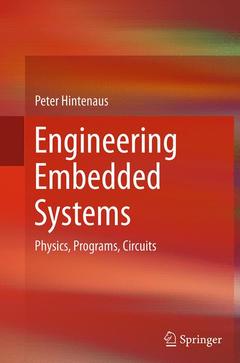Engineering Embedded Systems, Softcover reprint of the original 1st ed. 2015 Physics, Programs, Circuits
Auteur : Hintenaus Peter

This is a textbook for graduate and final-year-undergraduate computer-science and electrical-engineering students interested in the hardware and software aspects of embedded and cyberphysical systems design. It is comprehensive and self-contained, covering everything from the basics to case-study implementation.
Emphasis is placed on the physical nature of the problem domain and of the devices used. The reader is assumed to be familiar on a theoretical level with mathematical tools like ordinary differential equation and Fourier transforms. In this book these tools will be put to practical use.
Engineering Embedded Systems begins by addressing basic material on signals and systems, before introducing to electronics. Treatment of digital electronics accentuating synchronous circuits and including high-speed effects proceeds to micro-controllers, digital signal processors and programmable logic. Peripheral units and decentralized networks are given due weight. The properties of analog circuits and devices like filters and data converters are covered to the extent desirable by a systems architect. The handling of individual elements concludes with power supplies including regulators and converters.
The final section of the text is composed of four case studies:
? electric-drive control, permanent magnet synchronous motors in particular;
? lock-in amplification with measurement circuits for weight and torque, and moisture;
? design of a simple continuous wave radar that can be operated to measure speed and distance; and
? design of a Fourier transform infrared spectrometer for process applications.
End-of-chapter exercises will assist the student to assimilate the tutorial material and these are supplemented by a downloadable solutions manual for instructors. The ?pen-and-paper? problems are further augmented with laboratory activities. In addition to its student market, Engineering Embedded Systems will assist industrial practitioners working in systems architecture and the design of electronic measurement systems to keep up to date with developments in embedded systems through self study.
Models and Experiments.- Tools - Mainly Mathematics.- Voltage, Current, Basic Components.- Digital Electronics.- Programmable Devices - Software and Hardware.- Analog Circuits - Signal Conditioning and Conversion.- Energy Conversion - Power Supplies.- Energy Conversion - Motor Control.- Data Recovery from Noise - Lock-In Detection.- Short-Range Radar.- Infrared Spectrometry.- Appendices.
He has become the principal designer of the electronics and software of a Fourier transform infrared spectrometer. This instrument, marketed by the startup company i-red, has been installed at about 20 customer sites.
An optical moisture sensor of his design has been delivered to lead customers. Currently he teaches Computer Science at the University of Salzburg. His main research interests are Instrumentation and Measurement, Optical measurement systems and embedded and cyber-physical systems in general.
Date de parution : 09-2016
Ouvrage de 345 p.
15.5x23.5 cm
Date de parution : 11-2014
Ouvrage de 345 p.
15.5x23.5 cm



